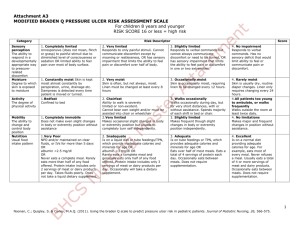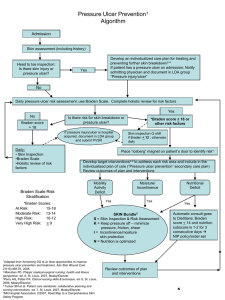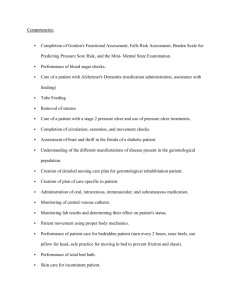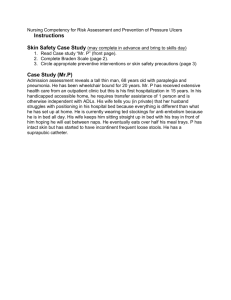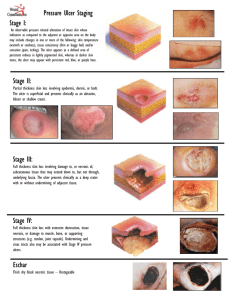braden q scale for predicting pressure ulcer risk.
advertisement
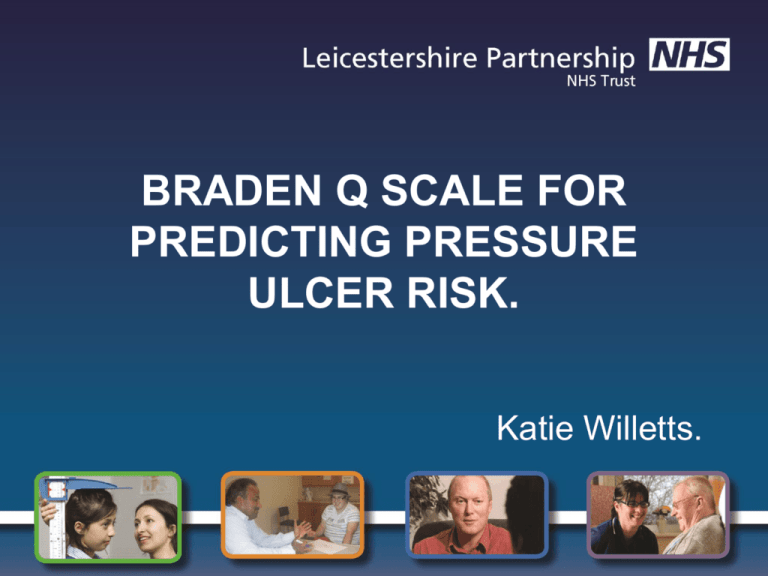
BRADEN Q SCALE FOR PREDICTING PRESSURE ULCER RISK. Katie Willetts. Braden Q. The Braden Q Scale for Predicting Paediatric Pressure Ulcer Risk (Braden Q Scale) is a widely used, valid, and reliable paediatric-specific pressure ulcer risk assessment tool. Quigley and Curley (1996) developed the Braden Q Scale for Predicting Paediatric Pressure Ulcer Risk by adapting the adult-based Braden Scale for Predicting Pressure Sore Risk (Bergstrom, Braden, Laguzza, & Holman, 1987) with the permission of its primary author (personal communication, Nancy Bergstrom, December 12, 1994). Braden Q Scale. • • • • • • The Braden Q Scale is composed of seven subscales. All seven subscales are rated from 1 (least favorable) to 4 (most favorable). Patients receive only one score per subscale. Total Braden Q Scale scores range from 7 (highest risk) to 28 (lowest risk), with a score of 16 or lower identifying patients at risk for pressure ulcers (Curley et al., 2003). A higher score generally indicates healthier patient condition and function. Patients are scored by physical assessment, patient/parent interview, and recorded observation (TPR, blood tests where available). Score Intensity and Duration of Pressure Mobility The ability to change and control body position 1. Completely Immobile: Does not make even slight changes in body or extremity position without assistance 2. Very Limited: Makes occasional slight changes in body or extremity position but unable to completely turn self independently. 3. Slightly Limited: Makes frequent though slight changes in body or extremity position independently. 4. No Limitations: Makes major and frequent changes in position without assistance. Activity The degree of physical activity 1. Bedfast: Confined to bed 2. Chair Fast: Ability to walk severely limited or non-existent. Cannot bear own weight and/or must be assisted in to chair or wheelchair. 3. Walks Occasionally: Walks occasionally during day, but for very short distances, with or without assistance. Spends majority of each shift in bed or chair. 4. All patients too young to ambulate OR walks frequently; Walks outside the room at least twice a day and inside room at least once every 2 hours during waking hours. Sensory Perception The ability to respond in a developmentally appropriate way to pressure – related discomfort 1. Completely Limited: Unresponsive (does not moan, flinch or grasp) to painful stimuli, due to diminished level of consciousness or sedation OR limited ability to feel pain over most of body surface. 2. Very Limited: Responds only to painful stimuli. Cannot communicate discomfort except by moaning or restlessness OR has sensory impairment which limits the ability to feel pain or discomfort over ½ the body. 3. Slightly Limited: Responds to verbal commands, but cannot always communicate discomfort or need to be turned OR has some sensory impairment which limits ability to feel pain or discomfort in 1 or 2 extremities. 4. No impairment: Responds to verbal commands. Has no sensory deficit, which limits ability to feel or communicate pain or discomfort. Score Tolerance of the Skin and Supporting Structure Moisture Degree to which skin is exposed to moisture 1. Constantly Moist: Skin is kept moist almost constantly by perspiration, urine, drainage etc… Dampness is detected every time patient is moved or turned. 2. Very Moist: Skin is often, but not always moist. Linen must be changed at least every 8 hours. 3. Occasionally Moist: Skin is occasionally moist, requiring linen change every 12 hour. 4. Rarely Moist: Skin is usually dry, routine diaper changes, linen only requires changing every 24 hours. Friction: Occurs when skin moves against support surfaces Shear: Occurs when skin and adjacent bony surface slide across one another 1. Significant Problem: Spasticity, contracture, itching or agitation leads to almost constant thrashing and friction. 2. Problem: Requires moderate to maximum assistance in moving. Complete lifting without sliding against sheets in impossible. Frequently slides down in bed or chair, requiring frequent repositioning with maximum assistance. 3. Potential Problem; Moves feebly or requires minimum assistance. During a move, skin probably slides to some extent against sheets, chair, restraints or other devices. Maintains relative good position in chair or bed most of the time but occasionally slides down. 4. No Apparent Problem: Able to completely lift patient during a position change; moves in bed and in chair independently and has sufficient muscle strength to lift up completely during move. Maintains good position in bed or chair at all times. Nutrition 1. Very Poor: NPO and/or maintained on clear liquids or IV’s for more than 5 days OR Albumin <2.5mg/dl OR never eats a complete meal. Rarely eats more than ½ of any food offered. Protein intake includes only 2 servings of meat or dairy products per day. Takes fluids poorly. Does not take a liquid dietary supplement. 2. Inadequate: Is on liquid diet or tube feedings/TPN which provide inadequate calories and minerals for age OR Albumin <3mg/dl OR rarely eats a complete meal and generally eats only about ½ of any food offered. Protein intake includes only 3 servings of meat or dairy products per day. Occasionally will take a dietary supplement. 3. Adequate: Is on tube feedings or TPN, which provide adequate calories and minerals for age OR eats over half of most meals. Eats a total of 4 servings of protein (meat, dairy products) each day. Occasionally will refuse a meal but will usually take a supplement if offered. 4. Excellent: Is on a normal diet providing adequate calories for age. For example; eats/drinks most of every meal/feeding. Never refuses a meal. Usually eats a total of 4 or more servings of meat and dairy products. Occasionally eats between meals. Does not require supplementation. 1. Extremely Compromised: Hypotensive (MAP <50mmHg; <40 in a newborn) OR the patient does not physiologically tolerate position changes. 2. Compromised: Normotensive; Oxygen saturation may be <95% OR haemoglobin may be <10mg/dl OR capillary refill may be >2seconds; Serum pH is<7.40. 3. Adequate Normotensive; Oxygen saturation may be <95% OR haemoglobin may be <10mg/dl OR capillary refill may be >2seconds; Serum pH is normal. 4. Excellent; Normotensive; Oxygen saturation >95%. Normal haemoglobin and capillary refill <2 seconds.. Usual food intake patterns Tissue Perfusion and Oxygenation Total Scoring the Braden Q Scale. Mobility Describes the patient's ability to independently change and/or control their body position. Descriptors range from completely immobile (1) to no limitations (4). Repositioning by the caregiver (such as parent or nurse) is not included when evaluating the patient's independent level of mobility. Assessment Patients can be assessed in any location, for example, in their bed/crib, chair/infant seat, wheelchair. Mobility. Scoring. 4. 3. 2. 1. No limitations. Makes major and frequent changes in position without assistance. Slightly limited. Makes frequent although slight changes in body or extremity position independently. Very limited. Makes occasional slight changes in body or extremity position but unable to completely turn self independently. Completely immobile. Does not make even slight changes in body or extremity position without assistance. Mobility How do I score these common scenarios? Score • 3-Month infant with good head control who can roll over front to back but not back to front • Patient moves independently • Epidural catheter for pain control, decreased movement of lower extremities, able to move rest of body well • Child able to make slight changes on own but needs assistance to fully turn • Hemiparesis, one side with decreased/no function (regardless of age) 4 4 3 2 2 Mobility. • Lower body paralysis, able to move and transfer (regardless of age) • Postoperative patient in lower extremity traction • Child with baseline neuromuscular weakness who can make slight changes in position but cannot turn self, sit unassisted, or walk • Patient in total body cast (spica) who cannot make even slight changes in body position and is turned by caregiver • Patient intubated and receiving neuromuscular blockade to support ventilation • Patient requiring assistance for all turns 2 2 2 1 1 1 Activity Describes the patient's current degree of physical activity. Descriptors range from bedfast (1) to walks frequently or patient too young to ambulate (4). Assessment Interview the primary caregiver about the patient's baseline developmental ability to ambulate. Activity is assessed from a developmental perspective, for example, many toddlers take their first steps between 9 and 12 months of age, cruise by moving on two feet while holding onto stationary objects, then walk independently by the time they are 15 months old. The Braden Q's activity subscale is scored based on the patient's acquisition of these developmental milestones by 15 months of age. After 15 months of age, all patients are scored on their current activity/ability to ambulate. Activity. Scoring 4. 3. Walks occasionally. Walks occasionally during day, but for very short distances, with or without assistance. Spends majority of each shift in bed or chair. 2. 1. All patients too young to ambulate OR walks frequently. Walks outside the room at least twice a day and inside room at least once every 2 hours during waking hours. Chair fast. Ability to walk severely limited or non-existent. Cannot bear own weight and/or must be assisted into chair or wheelchair. Bedfast. Confined to bed. Activity. How do I score these common scenarios? Score • All infants and toddlers ≤15 months old that are unable to walk from a developmental perspective (unable to independently walk across a room) • Otherwise healthy infant with pneumonia on mechanical ventilation • Patient who ambulates with a physical therapist twice a day, but chair fast or in bed most of the day • Ten month old infant who continues to “cruise" after hospital admission 4 4 3 3 Activity. Adolescent who can be pivoted from bed to chair Patient with cerebral palsy and spasticity who is only able to tolerate bed to chair for short periods Patient with spina bifida who is paraplegic Patient ordered for bed rest Ten month old infant who was cruising prior to admission and now on bed rest 2-Year-old in body cast, needs full assistance to be moved 8-Year-old asthmatic on continuous nebulizers and oxygen using a urinal Score 2 2 2 1 1 1 1 Sensory Perception. Describes the patient's ability to respond in a developmentally appropriate way to pressurerelated discomfort. Descriptors range from completely limited (1) to no impairment (4). Alterations in this subscale can be related to changes in level of consciousness, changes in sensation, or both. Common responses to pressure-related discomfort include movement and verbal or nonverbal clues, for example, facial grimacing or moaning. If the patient has a scoring difference between the consciousness and sensation parameters, then select the patient's lowest score. The most abnormal variable determines the patient's score, and the patient need not demonstrate all variables at a particular level. Assessment Review patient's medical record for a history of decreased motor response to sensory stimulus and/or assess the patient's sensory response to touch over bony prominences. Use progressive level of stimuli to assess level of consciousness; voice then touch then noxious stimulus. Use the Glasgow Coma Scale to assess level of consciousness or the State Behavioral Scale to assess level of sedation (Curley, Harris, Fraser, Johnson, & Arnold, 2006). Sensory Perception. Scoring 4. No impairment. Responds to verbal commands. Has no sensory deficit which limits ability to feel or communicate pain or discomfort. 3. Slightly limited. Responds to verbal commands but cannot always communicate discomfort or need to be turned OR has some sensory impairment which limits ability to feel pain or discomfort in one or two extremities. 2. Very limited. Responds only to painful stimuli. Cannot communicate discomfort except by moaning or restlessness OR has sensory impairment which limits the ability to feel pain or discomfort over half of body. 1. Completely limited. Unresponsive (does not moan, flinch, or grasp) to painful stimuli due to diminished level of consciousness or sedation OR limited ability to feel pain over most of body surface. Sensory Perception. How do I score these common scenarios? • 2-Year-old with pneumonia who cries when the nurse nears the crib, resists medical procedures, and communicates pain in a developmentally appropriate manner • 8-Year-old admitted to rule out appendicitis with pain score 7 of 10 • Lightly sedated intubated patient (State Behavioural Scale—1) • Nonverbal 5-Year-old with severe cognitive impairment who flinches with IV insertion and cries out when nappies are changed • Alert patient with spina bifida, no lower extremity Sensation • Epidural in place for lower extremity pain control • Heavily sedated patient who does not respond to a painful stimulus (State Behavioral Scale—3) Score 4 4 3 3 2 2 1 Moisture. Describes the degree to which the patient's skin over bony prominences is exposed to moisture. Subscale descriptors range from constantly moist (1) to rarely moist (4). The frequency of linen change is used as a proxy measure to describe situations were body fluids are not contained by a continence device or a dressing. Moisture includes perspiration, urine, faeces, wound drainage, or any other drainage that would be detrimental to skin integrity over bony prominences. Assessment Skin moisture is determined by touch or visualization over bony prominences. Skin fold moisture is not considered. Number of linen changes due to perspiration, draining wounds, and incontinence are noted. Moisture. Scoring 4. Rarely moist. Skin is usually dry, routine nappy changes, linen only requires changing every 24 hours. 3. Occasionally moist. Skin is occasionally moist, requiring linen change every 12 hours. 2. Very moist. Skin is often but not always moist. Linen must be changed at least every 8 hours. 1. Constantly moist. Skin is kept moist almost constantly by perspiration, urine, drainage, etc. Dampness is detected every time patient is moved or turned. Moisture. How do I score these common scenarios? • Patient has urinary tube and rectal pouch. No leakage from either but would be constantly moist if tube/pouch not in place • 4-Year-old who is febrile and sweaty, linens changed twice a day • 5-Year-old with recent abdominal procedure with placement abdominal drain and also with faecal Incontinence • Patient with large abdominal wound requiring minimum of three dressing changes a day. Bed linens moist and changed with each dressing change • Infant with 12 liquid stools per day, contained by nappies • Patient post hypoxic ischemic event with temperature instability and frequent diaphoretic episodes Score 4 3 2 2 1 1 Friction and Shear. Friction occurs when the patient's skin moves against a support surface, whereas shear occurs when skin and the adjacent bony surface slide across one another. Descriptors in this subscale range from a significant problem (1) to no apparent problem (4). The patient's ability to move or assist with movement or a caregiver's ability to lift a patient off the bed, versus sliding or dragging, is considered when evaluating friction. The patient's ability to maintain a position in bed, versus sliding down, is considered when evaluating shear. Many paediatric patients can be lifted to prevent friction or shear. Extremes in this category include patients with choreoathetoid movement disorders. Assessment Patient observation over time and discussion with parent / carer. Scoring Friction and Shear. 4. No apparent problem. Able to completely lift patient during a position change; moves in bed and chair independently and has sufficient muscle strength to lift up completely during move. Maintains good position in bed or chair at all times. 3. Potential problem. Moves feebly or requires minimum assistance. During a move, skin probably slides to some extent against sheets, chair, restraints, or other devices. Maintains relative good position in chair or bed most of the time but occasionally slides down. 2. Problem. Requires moderate to maximum assistance in moving. Complete lifting without sliding against sheets is impossible. Frequently slides down in bed or chair, requiring frequent repositioning with maximum assistance. 1. Significant problem. Spasticity, contracture, itching, or agitation leads to almost constant thrashing and friction. Friction and Shear. How do I score these common scenarios? • 12-Year-old with cystic fibrosis receiving chest physiotherapy and antibiotics, no activity restrictions • Toddler on non-invasive ventilation (CPAP) who occasionally thrashes trying to remove mask • 12-Year-old with cerebral palsy and contractures, elbows are red from rubbing on the bed • Patient in Buck's traction, or lower extremity pin traction, or halo traction • Patient post head injury who is unable to maintain proper body alignment and requires frequent repositioning due to sliding down in bed • Postoperative patient who intermittently thrashes or is agitated throughout day • Patients supported on high-frequency oscillatory Ventilation • Patients with choreoathetoid movement disorders • School-age child with severe eczema and open lesions from severe pruritis Score 4 3 2 2 2 2 1 1 1 Nutrition. The patient's nutrition is assessed by considering their usual food intake pattern. Descriptors range from very poor (1) to excellent (4). Very poor is identified when the patient has experienced less than a full caloric intake per kilogram of body weight for five consecutive days. The initiation of alternative methods of feeding, for example, enteral or parenteral nutrition, does not automatically assure adequate nutrition. Serum albumin levels may also be used to describe the adequacy of the patient's nutrition. Assessment Evaluate the patient's nutritional intake for the five consecutive days prior to the scoring, no matter the patient location. In infants, formula or human milk feedings are equivalent to a meal. Assess enteral feedings, parenteral nutrition, and serum albumin and/or prealbumin levels. Scoring 4. 3. 2. 1. Nutrition. Excellent. Is on a normal diet providing adequate calories for age, for example, eats/drinks most of every meal/feeding. Never refuses a meal. Usually eats a total of four or more servings of meat and dairy products. Occasionally eats between meals. Does not require supplementation. Adequate. Is on tube feedings or total parenteral nutrition (TPN), which provides adequate calories and minerals for age OR eats over half of most meals. Eats a of four servings of protein (meat, dairy products) each day. Occasionally will refuse a meal but will usually take a supplement if offered. Inadequate. Is on liquid diet or tube feedings/TPN, which provides inadequate calories and minerals for age OR albumin less than 3 mg/dl OR rarely eats a complete meal and generally eats only half of any food offered. Protein intake includes only three servings of meat or dairy products per day. Occasionally will take a dietary supplement. Very poor. NPO (nil per os) and/or maintained on clear liquids, or IVs for more than 5 days OR albumin less than 2.5 mg/dl OR never eats a complete meal. Rarely eats more than half of any food offered. Protein intake includes only two servings of meat or dairy products per day. Takes fluids poorly. Does not take a liquid dietary supplement. Nutrition. How do I score these common scenarios? Score • Infant on infant formula, 8–10 feeds per day • Healthy breast-fed infant, NPO since operation earlier in the day • Infant receiving adequate calories via TPN or supplemental enteral feeds • Child admitted 3 days ago with dehydration and viral illness who continues with vomiting and diarrhoea on maintenance IV fluids • Teenager on liquid diet for 6 days with inadequate caloric intake • Surgical patient NPO for long periods every 2 to 3 days because of staged surgical procedures 4 4 3 2 2 2 Nutrition. How do I score these common scenarios? Child malnourished (weight-for-age equal to or less than −2 standard deviations of growth standards median) on admission due to poor oral intake for 2 weeks • Postoperative patient with limited intake—sips of clears to bites of solids for 4–5 days Postoperatively • 6-Year-old with severe developmental delay on enteral tube feedings admitted yesterday with albumin level of 2 and below the 10th percentile for weight Score 1 1 1 Tissue Perfusion and Oxygenation Describes the patient's perfusion and oxygenation status. Descriptors range from extremely compromised (1) to excellent (4). The availability of blood studies (haemoglobin) and noninvasive technology (oxygen saturation by pulse oximetry) allows for in-depth analysis of a patient's tissue tolerance. The patient is scored on a combination of factors, including current blood pressure, haemoglobin, oxygen saturation, capillary refill, and serum pH. In extreme, the patient's hemodynamic tolerance response to a position change is also assessed. The most abnormal variable determines the patient's score, and the patient need not demonstrate all variables at a particular level. The level of hemodynamic, vasopressor, ventilator, and oxygen support interventions is not considered—just their net result on hemodynamic status. Assessment Assess the patient's pulse oximetry (SpO2) reading, blood studies, capillary refill, and patient's physiologic response to a change in position. Not all variables need to be available. The most abnormal finding determines the patient's score. Tissue Perfusion and Oxygenation Scoring 4. Excellent. Normotensive, oxygen saturation greater than 95%, normal haemoglobin, and capillary refill less than 2 seconds. 3. Adequate. Normotensive, oxygen saturation may be less than 95% OR haemoglobin may be less than 10 mg/ dl OR capillary refill may be more than 2 seconds; serum pH is normal. 2. Compromised. Normotensive, oxygen saturation may be less than 95% OR haemoglobin may be less than 10 mg/dl OR capillary refill may be more than 2 seconds; serum pH is normal. 1. Extremely compromised. Hypotensive (mean arterial pressure b50mmHg; b40 in a new-born) OR the patient does not physiologically tolerate position changes. Tissue Perfusion and Oxygenation How do I score these common scenarios • 5-Year-old on supported on mechanical ventilation and dopamine drip; vital signs normal for age, normal oxygen saturation, serum pH 7.4 • 14-Year-old post left femur fracture repair in long leg cast with capillary refill 3–4 seconds • Oxygen saturation 100% with 2 L of oxygen via nasal cannula, haemoglobin 8 g/dl • Child with normal blood pressure but haemoglobin less than 10 g/dl • Baby with unrepaired congenital heart defect, baseline oxygen saturation 82%, otherwise stable blood pressure and haemoglobin Score 4 3 3 3 2 Tissue Perfusion and Oxygenation How do I score these common scenarios • 3-Year-old status post abdominal surgery. No complete blood cell count results available, capillary refill time 2 seconds, oxygen saturation 94% on room Air • 5-Year-old on high-frequency oscillatory ventilation, blood pressure decreases with any position changes • Patient admitted 24 hours ago requiring IV fluid boluses for hypotensive episodes, with significant oxygen requirement to keep oxygen saturations greater than 92% Score 2 1 1 Once the Braden Q Scale is completed, the subscale scores are totalled. If the patient's total score is 16 or less, then interventions to prevent pressure ulcer development are implemented. It makes intuitive sense to target interventions to bolster the less than optimal subscale, for example, optimizing nutrition if the patient scores 3 or less in the nutrition subscale or instituting a strict repositioning schedule if the patient scores 2 or less in the mobility subscale. Common Questions. Q. Can I base risk reduction interventions/strategies based on a subscale score instead of total score? A. The total Braden Q Scale scores should be computed to identify patients at risk, and then sub scores can be used to focus risk reduction intervention strategies. Remember that clinical judgement should over ride any score. Q. If my patient scores ≤16, is the patient considered low risk or high risk for pressure ulcer development? A. The patient is considered “at risk.” Degree of risk is not relevant. Once a patient is determined to be at risk, then appropriate nursing interventions should be implemented based upon the most “at-risk” subscale. Q. Can the Braden Q Scale be used in paediatric hospice or home care? A. Yes, the Braden Q Scale is a paediatric-specific tool that was based on Bergstrom and Braden's conceptual framework of tissue ulceration. Most of the Bergstrom and Braden's original work was conducted in chronic care facilities. Common Questions. Q. I don't understand how to score the subscales that contain an “OR” statement. A. “OR” statements are used to provide multiple assessment points. When used, the patient need only have one of the elements listed. Score the patient on the variable that provides the lowest score. Q. What if I don't have all the data to complete a subscale? A. Use available data to categorize the patient. If no data are available, we suggest assigning the worst possible score of “1” to err on the intervention side. NICE Guidance. PREVENTION: NEONATES, CHILDREN AND YOUNG PEOPLE. Risk assessment. Carry out and document an assessment of pressure risk for neonates, infants, children and young people: Receiving NHS care in primary and community settings if they have a risk factor, for example: • Significantly limited mobility. • Significant loss of sensation. • Previous or current pressure ulcer. • Nutritional deficiency. • Inability to reposition themselves. • Significant cognitive impairment. Skin assessment Offer neonates, infants, children and young people who are assessed as being at risk of developing a pressure ulcer a skin assessment by a trained healthcare professional. Take into account: • skin changes in the occipital area • skin temperature • the presence of blanching erythema or discoloured areas of skin. Be aware of specific sites (for example, the occipital area) where neonates, infants, children and young people are at risk of developing a pressure ulcer. This includes medical devices i.e. masks and tubing pressing onto skin. Repositioning. • • • • • Ensure that neonates and infants who are at risk of developing a pressure ulcer are repositioned at least every 4 hours. Encourage children and young people who are at risk of developing a pressure ulcer to change their position at least every 4 hours. If they are unable to reposition themselves, offer help to do so, using appropriate equipment if needed. Consider more frequent repositioning than every 4 hours for neonates and infants who have been assessed as being at high risk of developing a pressure ulcer. Document the frequency of repositioning required. Encourage children and young people who have been assessed as being at high risk of developing a pressure ulcer to change their position more frequently than every 4 hours. If they are unable to reposition themselves, offer help to do so, using equipment if needed. Document the frequency of repositioning required. Ensure that repositioning equipment is available to aid the repositioning of children and young people, if needed. Repositioning con’t • • • • Ensure that healthcare professionals are trained in the use of repositioning equipment. Ensure that patients, parents and carers understand the reasons for repositioning. If children and young people decline repositioning, document and discuss their reasons for declining. Consider involving a play expert to encourage children who have difficulty with, or who have declined repositioning. Relieve pressure on the scalp and head when repositioning neonates, infants, children and young people at risk of developing a pressure ulcer. Skin Massage and Nutrition. • DO NOT offer skin massage or rubbing to neonates, infants, children and young people to prevent a pressure ulcer. • DO NOT offer nutritional supplements specifically to prevent a pressure ulcer in neonates, infants, children and young people with adequate nutritional status for their developmental stage and clinical condition. • DO NOT offer subcutaneous or intravenous fluids specifically to prevent a pressure ulcer in neonates, infants, children and young people with adequate hydration status for their development stage and clinical condition. Pressure redistributing devices. • Use a high-specification foam cot mattress or overlay for all neonates and infants who have been assessed as being at high risk of developing a pressure ulcer as part of their individualised care plan. • Use a high-specification foam mattress for all children and young people who have been assessed as being at high risk of developing a pressure ulcer as part of their individualised care plan. • Discuss with children and young people at high risk of developing a heel pressure ulcer and their parents and carers, where appropriate, a strategy to offload heel pressure as part of their individualised care plan. Remember lower limb pathway. • Offer infants, children and young people who are long-term wheelchair users, regular wheelchair assessments and provide pressure relief or redistribution. • Offer neonates, infants, children and young people at risk of developing an occipital pressure ulcer an appropriate pressure redistributing surface (for example, a suitable pillow or pressure redistributing pad). Barrier Creams. Use barrier preparations to help prevent skin damage, such as moisture lesions, for neonates, infants, children and young people who are incontinent. Remember not Sudocrem as it blocks the non-return layer on continence pads/nappies when applied too liberally! Prevention. Care planning that includes: • Individualised plan. • Outcome of risk and skin assessment. • Need for additional pressure relief at specific sites. • Mobility and ability to reposition themselves. • Comorbidities. • Patient preference. Our Core care plan and SSKIN covers this! Patient and Carer Information: Remember - SSKIN leaflet! • • • • • The cause of a pressure ulcer. Early signs of a pressure ulcer. Ways to prevent a pressure ulcer. Implications of having a pressure ulcer. Demonstrate techniques and equipment used to prevent a pressure ulcer. Management. • • • • • • • • • • Measurement. Categorisation. Nutrition. Pressure redistributing devices. Systemic and topical antimicrobials, antiseptics and antibiotics. Dressings. Heel pressure ulcers. TV referral – see new form Incident Reporting for Category for 2, 3, 4’s. Completion of wound assessment cha and photo (when appropriate)
